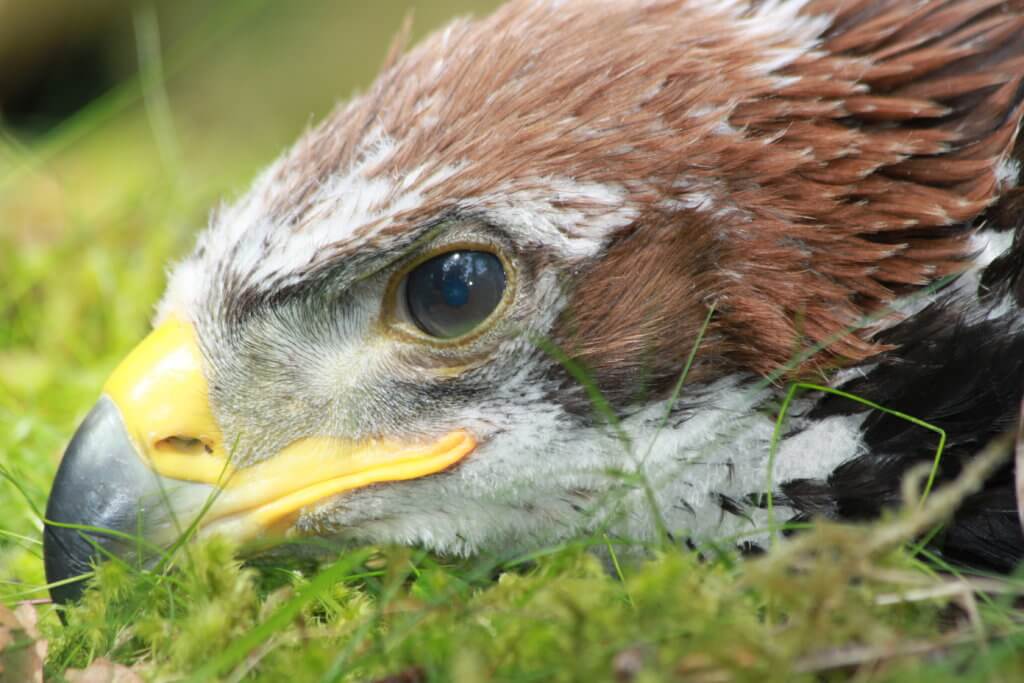
Press release:
Golden eagle persecution 7 miles from Scotland’s Parliament?
A young satellite-tagged golden eagle has disappeared in highly suspicious circumstances in the Pentland Hills, just seven miles from the Scottish Parliament building in Edinburgh.
The eagle had hatched at a nest site in the Scottish Borders in 2017 and last June, in cooperation with the landowner, conservationists fitted him with a state-of-the-art tracking device to follow his movements as part of a new project initiated by broadcaster and campaigner Chris Packham, and Dr Ruth Tingay of Raptor Persecution UK. The landowner named the eagle Fred after his grandson.
Data from Fred’s tag showed he stayed within his parents’ territory for several months after fledging but in mid-January he made his first exploratory flight away from home. He headed to the Pentland Hills and spent a few days ‘woodland hopping’ around the northern edge, at one point just half a kilometre from the City Bypass.
His tag was working perfectly and was providing the researchers with accurate and frequent GPS locations.
On 20th January, Fred roosted overnight in a shelter belt overlooking a grouse moor near Balerno. His tag continued to record his position there until just before 10am on 21st January, when his tag suddenly and inexplicably stopped.
However, three and a half days later, in the evening of 24 January, Fred’s tag began transmitting again but the GPS location showed it was in the North Sea, some 10 miles offshore from St. Andrews. His tag continued to provide GPS data until 26 January, showing his final position at approximately 15 miles offshore. No further data have been received.
Dr Tingay said: “It is beyond doubt that Fred’s disappearance is highly suspicious. Golden eagles don’t generally fly out for miles over large bodies of sea water but even if Fred had done so, apart from defying everything we’ve learned about Scottish golden eagle behaviour, we would have seen excellent tracking data plotting his route given the reliability of his tag.
While we will probably never know for sure, it seems likely that Fred was killed soon after 10am on 21 January, his tag was hidden to suppress the signal and then he and the tag were dumped in the North Sea. If this is indeed the case, it’s just the latest example of when those who have killed a protected bird of prey have tried to cover up evidence of their crime”.
Chris Packham said: “Once again, we have the suspicious disappearance of a satellite-tagged golden eagle in an area managed for driven grouse shooting. What’s truly shocking about this case is that it didn’t take place in a remote Highland glen miles from anywhere, but it happened within a stone’s throw of Edinburgh, right under the noses of the Scottish Government. What must the good people of Edinburgh think, to learn that golden eagles aren’t even safe on their doorstep? That they’ve been denied the opportunity to see this iconic, magnificent bird in their local hills? This doesn’t bode well for the planned reintroduction of golden eagles to south Scotland, due to begin later this year”.
Last year a Scottish Government-commissioned report showed that 41 of 131 satellite-tagged golden eagles had disappeared (presumed dead) in suspicious circumstances in Scotland, predominantly on or near to some driven grouse moors. In response to the report’s findings, Environment Cabinet Secretary Roseanna Cunningham ordered a review of grouse moor management practices with a view to introducing a licensing scheme for game-shooting estates.
Anyone with information about Fred’s disappearance is urged to contact Police Scotland on 101.
ENDS
Mark writes: this news is the first from the project that was announced at the Bird Fair on a sunny day last August. It’s very notable that the news has emerged rapidly and clearly. And what a story! A young eagle leaves his natal territory in mid-January and is dead about a week later, and the body dumped in the sea!
Not only does this show the rapidity with which birds of prey can be ‘disappeared’ when beginning to set out from safe territories, it also demonstrates the extreme lengths to which the wildlife criminals will go to cover up their tracks. Any other explanations for these events?
[registration_form]
Are these the type of GPS tags that can be blocked with tinfoil or a crisp wrapper (like this Australian did with his workplace tracker: http://www.theweek.co.uk/90003/electrician-skipped-work-140-times-with-crisp-packet-trick ) because if they are then we all know what happened. Shot/poisoned, tag wrapped with foil, then chucked in a river for disposal, the blocking material finally washing off when in the ocean.
Yup. If you shield any RF device it will be blocked.
My sister moved to Currie near Edinburgh a couple of years ago. It was only last year that I learned she was actually very close to a grouse moor, I had never known there were any in the Pentland hills and this came as a bloody big surprise/shock to me. That alone demonstrated one thing grouse moors only mean something (in positive terms) to a very, very small number of people and can exist under the radar where there is any significant local population above and beyond what is needed to provide the labour for grouse shooting. Grouse moors general ‘cultural’ value is near zilch, they are adding nothing to the Pentlands certainly. I think now though that their local profile might be about to get a lot higher. How many people would love the chance to see an eagle in the Pentlands, Border hills, Slamannan plateau, Ochil hills etc, etc?
They can hide the bodies. They can even dump them at sea. But they can’t hide the pattern about where all these birds disappear. That is evidence in itself and it is damning.
I hope this event gets lots of publicity in Scotland.